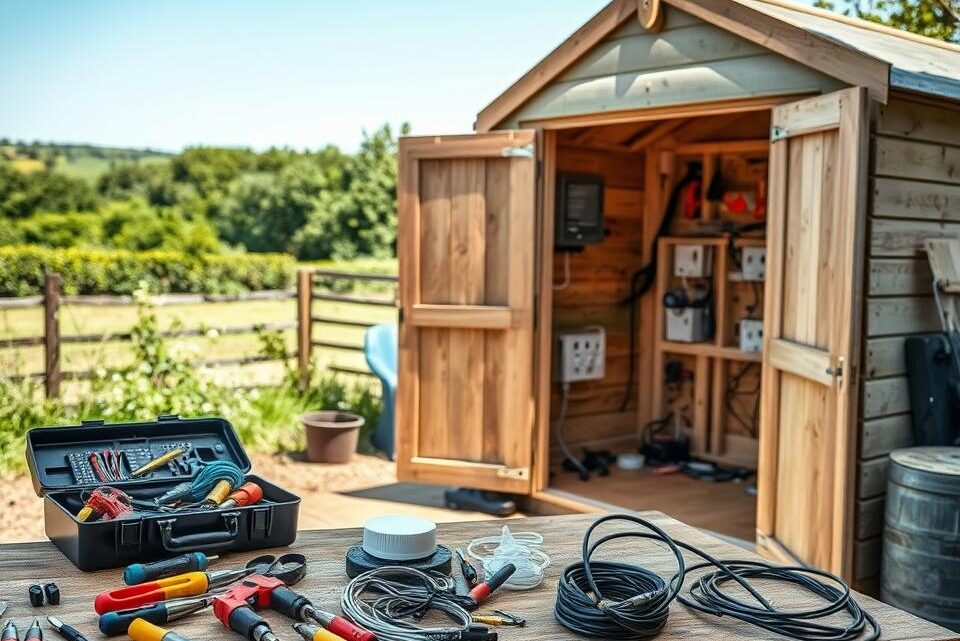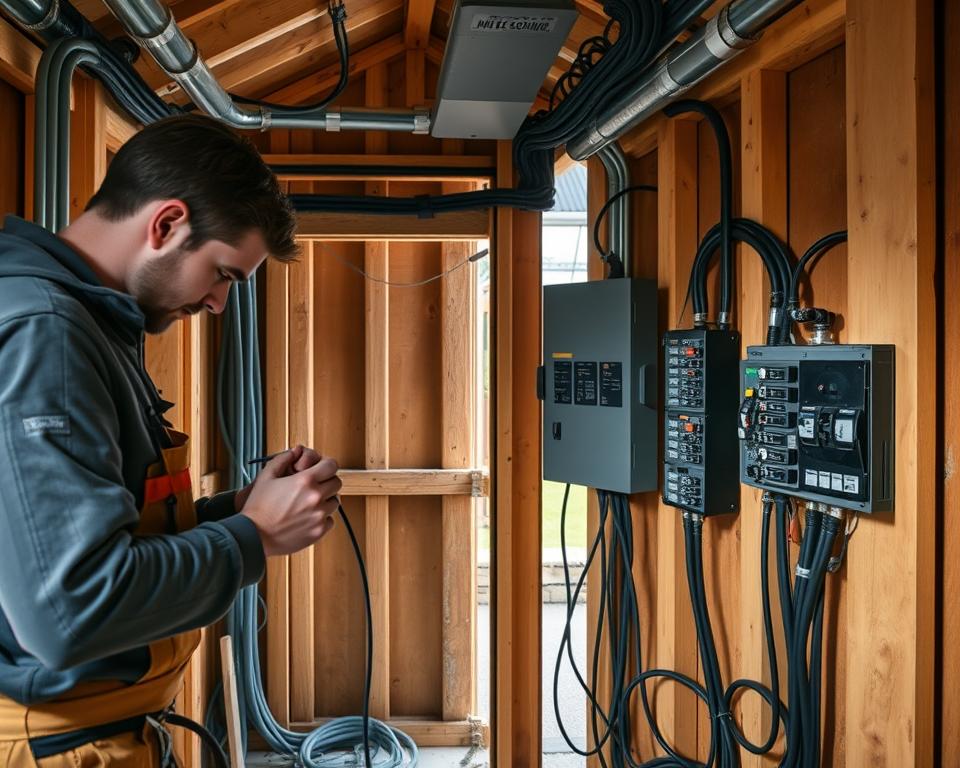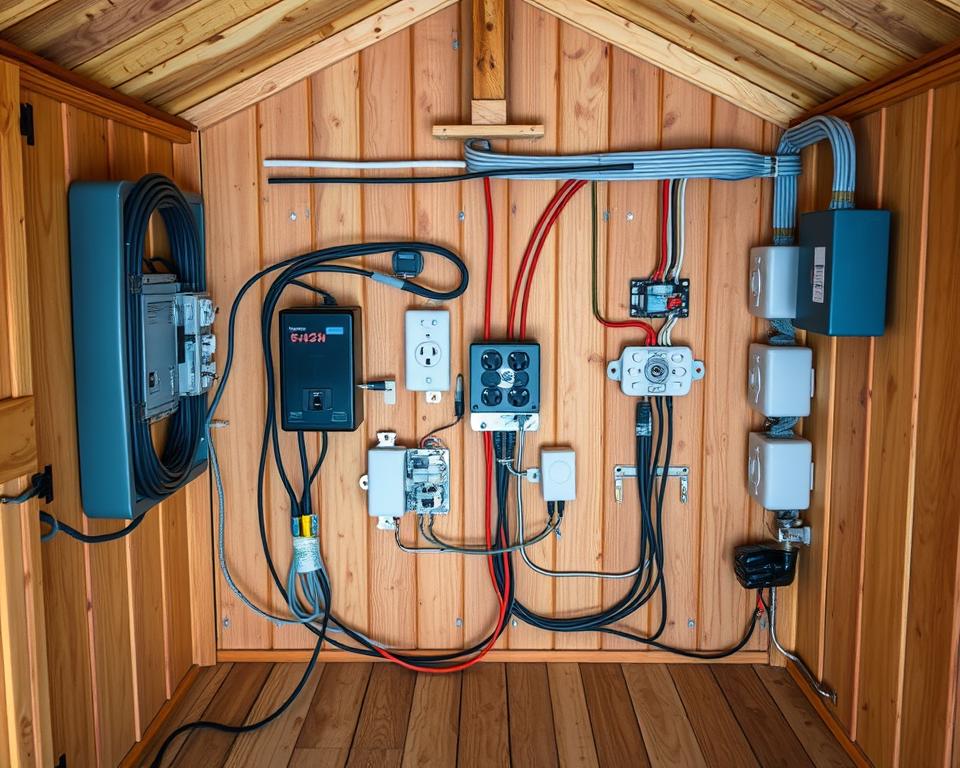How to Run Mains Power to a Shed in the UK

Running mains power to a shed in the UK requires careful planning and professional expertise. Whether you want to create a home office, workshop, or recreational space, electrical installation demands precision and adherence to strict safety standards.
UK shed electrification involves navigating complex building regulations and electrical codes. Homeowners must understand the critical steps to ensure a safe and compliant mains power setup for their garden building.
Professional guidance is essential when undertaking mains power for shed projects. Electrical work involves intricate technical knowledge and legal requirements that protect both property and personal safety.
Inhaltsverzeichnis
Key Takeaways
- Professional electrical expertise is crucial for shed power installation
- Building regulations must be strictly followed
- Safety should always be the primary consideration
- Proper documentation and certification are mandatory
- Electrical standards in the UK are stringent and complex
Planning and Legal Requirements for Shed Electrification
Electrifying a garden shed in the UK involves navigating complex legal requirements to ensure safety and compliance. Understanding the key regulations will help you complete your project successfully and avoid potential legal pitfalls.
Electrical work in residential properties must adhere to strict UK building regulations. These guidelines protect homeowners and ensure electrical installations meet critical safety standards.
Building Regulations and Part P Compliance
Part P compliance is a crucial aspect of electrical work in domestic settings. This specific regulation requires that all electrical installations are:
- Designed and installed by competent professionals
- Inspected and tested to confirm safety
- Documented with appropriate certification
Required Permits and Documentation
Before starting your shed electrification project, you’ll need to secure appropriate electrical permits. The process typically involves:
- Obtaining a detailed electrical installation plan
- Submitting documentation to local building control
- Arranging for professional inspection and sign-off
Choosing a Qualified Electrician
Selecting the right professional is critical for UK building regulations compliance. Look for electricians who are:
- Registered with official bodies like NICEIC or ELECSA
- Experienced in garden shed electrical installations
- Able to provide comprehensive certification
By following these guidelines, you’ll ensure a safe, legal, and professionally executed electrical project for your garden shed.
Essential Tools and Materials Needed
Preparing for a shed electrical installation requires careful selection of electrical tools and shed wiring materials. Professional electricians and DIY enthusiasts must gather specific equipment to ensure a safe and successful project.
Your toolkit for shed electrical work should include several critical categories of equipment:
- Measuring and Marking Tools
- Professional digital multimeter
- Tape measure
- Spirit level
- Cable detector
- Cutting and Stripping Tools
- Wire strippers
- Cable cutters
- Hacksaw
- Connection and Installation Tools
- Screwdrivers (flathead and Phillips)
- Adjustable wrench
- Crimping tool
When selecting shed wiring materials, prioritise quality and safety. Essential materials include:
- Underground armoured cable
- Waterproof electrical junction boxes
- Circuit breakers
- Earthing rods
- Electrical conduit
Safety tip: Always purchase materials that meet British electrical standards and are compatible with your specific shed electrical setup.
Investing in high-quality electrical tools and shed wiring materials will streamline your installation process and help prevent potential electrical hazards.
Understanding Electrical Supply Options for Garden Buildings
Garden building electrification requires careful planning and consideration of various electrical supply options. Homeowners need to evaluate the most suitable approach for powering their garden structures safely and efficiently.

When exploring electrical supply options for garden buildings, two primary methods emerge as the most common approaches:
- Direct mains connection
- Sub-circuit installation
Direct Mains Connection Versus Sub-Circuit Installation
The choice between direct mains connection and sub-circuit installation depends on several critical factors. A direct mains connection provides a dedicated power line directly from your home’s primary electrical panel, while a sub-circuit installation creates a separate electrical pathway.
| Connection Type | Pros | Cons |
|---|---|---|
| Direct Mains Connection | Higher power capacity | More expensive installation |
| Sub-Circuit Installation | Lower cost | Limited power supply |
Power Requirements Calculation
Calculating power requirements is crucial for garden building electrification. You’ll need to assess:
- Total wattage of planned electrical devices
- Anticipated usage frequency
- Future expansion potential
Cable Types and Specifications
Selecting appropriate cable types ensures safe and reliable electrical supply options. Underground armoured cables are typically recommended for garden building installations, providing robust protection against environmental factors.
Professional consultation remains essential to determine the most suitable electrical configuration for your specific garden building requirements.
How to Run Mains Power to a Shed in the UK
Running mains electricity for sheds requires careful planning and professional expertise. UK shed power installation is not a simple DIY project but a complex process that demands technical knowledge and adherence to safety regulations.

Before beginning your UK shed power installation, you’ll need to consider several critical factors:
- Distance from the main electrical supply
- Cable routing and protection
- Power requirements for your specific shed
- Compliance with electrical safety standards
The key steps for successful mains electricity for sheds involve:
- Conducting a thorough site survey
- Calculating electrical load requirements
- Selecting appropriate cable types
- Preparing underground cable routes
Professional electricians recommend using armoured cable for underground installations to ensure maximum protection against environmental damage.
| Installation Component | Recommended Specification |
|---|---|
| Cable Type | SWA (Steel Wire Armoured) Underground Cable |
| Minimum Cable Depth | 450mm Below Ground Level |
| Circuit Protection | RCD and Appropriate Circuit Breaker |
Always prioritise safety and consult a qualified electrician to ensure your UK shed power installation meets all necessary electrical regulations.
Trench Digging and Cable Protection Methods
Underground cable installation requires careful planning and precise execution. The process of trench digging for electrical cables is a critical step in ensuring a safe and reliable power connection to your garden shed.

Proper preparation is key to successful underground cable installation. Electrical professionals follow strict guidelines to protect cables and ensure long-term performance.
Proper Trench Depth Guidelines
When installing underground electrical cables, depth is crucial for safety and protection. The standard depth requirements include:
- Minimum trench depth of 450mm for electrical cables
- Increased depth to 750mm near building foundations
- Additional protection required in areas with potential ground disturbance
Underground Cable Protection Requirements
Trench digging for electrical cables demands comprehensive protection strategies. Installers use multiple methods to safeguard underground cables:
| Protection Method | Purpose |
|---|---|
| Protective Conduit | Shields cables from physical damage |
| Warning Tape | Alerts diggers to cable presence |
| Cable Markers | Indicates precise cable route |
Marking and Recording Cable Routes
Accurate documentation of underground cable installation is essential. Professionals recommend:
- Creating detailed site sketches
- Using GPS coordinates for precise location
- Photographing trench and cable placement
- Maintaining a permanent record for future reference
Pro tip: Always consult a qualified electrician to ensure compliance with local regulations and safety standards during underground cable installation.
Installing the Consumer Unit and Circuit Breakers

The shed consumer unit installation is a critical step in creating a safe electrical system for your garden building. This essential component serves as the heart of your shed’s electrical infrastructure, protecting your circuits and ensuring electrical safety.
Selecting the right consumer unit requires careful consideration. The unit must match your shed’s specific power requirements and provide adequate protection for all electrical circuits.
- Choose a consumer unit with sufficient ways for your electrical circuit breakers
- Ensure compatibility with your shed’s electrical load
- Select a unit that meets current British electrical standards
When installing electrical circuit breakers, precision is paramount. Each breaker must be correctly rated and positioned to protect specific circuits within your shed. Professional electricians recommend:
- Mounting the consumer unit at a convenient height
- Ensuring proper ventilation around the unit
- Labelling each circuit breaker clearly
“Proper installation of your consumer unit is not just about functionality, but about ensuring the safety of your electrical system.” – UK Electrical Safety Foundation
Always consult a qualified electrician for shed consumer unit installation. They will ensure compliance with Part P building regulations and guarantee a safe, professional setup.
Wiring Installation and Connection Procedures
Successful shed wiring installation requires precision, careful planning, and adherence to electrical connection procedures. Homeowners must understand the critical steps involved in creating a safe and functional electrical system for their garden building.

Professional electrical work demands meticulous attention to detail and strict safety protocols. The following guidelines will help ensure a robust and compliant electrical setup.
Cable Termination Techniques
Proper cable termination is crucial for reliable electrical connections. Electricians follow specific methods to secure and connect wires safely:
- Strip cable insulation carefully using professional-grade wire strippers
- Use appropriate terminal blocks for secure connections
- Ensure tight connections with recommended torque specifications
- Protect termination points with appropriate insulation sleeves
Earthing Requirements
Earthing creates a critical safety mechanism for electrical systems. Correct grounding prevents electrical shock and protects against potential equipment damage.
| Earthing Method | Application | Safety Rating |
|---|---|---|
| Copper Earth Rod | Garden Shed Installations | High Protection |
| Main Building Earth Connection | Direct Power Supply | Maximum Safety |
Testing and Certification
Electrical connection procedures culminate in comprehensive testing. A qualified electrician will perform Electrical Installation Condition Report (EICR) assessments to verify system integrity and safety compliance.
- Conduct insulation resistance tests
- Verify earth fault loop impedance
- Check circuit breaker functionality
- Obtain official certification documentation
Professional certification ensures your shed wiring installation meets UK electrical safety standards, providing peace of mind and legal compliance.
Safety Measures and Maintenance Tips
Maintaining electrical safety for sheds requires consistent attention and proactive care. Garden building maintenance is crucial to prevent potential hazards and ensure long-term reliability of your electrical installation.
Regular inspections form the cornerstone of electrical safety. Homeowners should develop a structured approach to checking their garden building’s electrical systems.
- Conduct visual inspections every six months
- Check for signs of cable damage or wear
- Ensure all electrical connections remain tight and secure
- Keep the area around electrical installations clean and unobstructed
Potential warning signs requiring immediate professional attention include:
- Flickering lights
- Burning smells near electrical outlets
- Unusual buzzing sounds
- Tripped circuit breakers
| Maintenance Task | Frequency | Purpose |
|---|---|---|
| Visual Cable Inspection | Every 6 months | Detect potential damage |
| Professional Electrical Check | Annually | Comprehensive system assessment |
| RCD Testing | Every 12 months | Verify safety switch functionality |
Professional expertise remains invaluable for complex electrical maintenance tasks. While routine checks can be performed by homeowners, always consult a qualified electrician for comprehensive electrical safety assessments in garden buildings.
Conclusion
Running mains power to a shed in the UK requires careful planning, technical expertise, and strict adherence to safety regulations. Our comprehensive UK shed electrification guide has walked you through the essential steps of creating a safe and functional electrical installation for your garden building.
The mains power installation summary highlights the critical importance of professional involvement. Working with a certified electrician ensures compliance with Building Regulations Part P, proper cable protection, and correct electrical system design. Each stage, from initial planning to final testing, demands meticulous attention to detail and respect for electrical safety standards.
Your newly electrified shed represents more than just a power connection – it’s an investment in functionality and versatility. Whether you’re creating a home office, workshop, or recreational space, understanding the technical requirements empowers you to make informed decisions. Remember that professional guidance and rigorous safety protocols are your best allies in transforming your garden building into a powered, practical space.
With careful planning and expert support, your shed can become a reliable, safe, and efficient extension of your home. Embrace the opportunity to enhance your garden workspace while prioritising electrical safety and regulatory compliance.
FAQ
Do I need permission to run electricity to my garden shed?
Yes, you typically need permission and must comply with Building Regulations Part P. This ensures electrical work is safely completed by a qualified professional or properly notified to local authorities. You’ll need to obtain the necessary permits and potentially have the installation certified by a registered electrician.
How much does it cost to install mains power in a garden shed?
The cost varies depending on the distance from your main electrical supply, the complexity of the installation, and the amount of electrical work required. Typically, you can expect to spend between £500 and £2,000, including labour, materials, and certification. Factors like trench digging, cable length, and additional electrical components will influence the total expense.
Can I install the electrical connection myself?
In the UK, electrical installations must be completed by a qualified, registered electrician. DIY electrical work in sheds is not recommended and can be dangerous. Only Part P certified electricians can legally complete mains power connections and provide the necessary certification for insurance and safety purposes.
What cable type is best for underground shed electricity?
For underground electrical connections, you’ll need SWA (Steel Wire Armoured) cable, which is specifically designed for outdoor and underground use. This cable provides protection against moisture, physical damage, and environmental challenges. The specific cable size will depend on your shed’s power requirements and distance from the main supply.
How deep should I dig the trench for electrical cables?
UK regulations typically require underground cables to be buried at a minimum depth of 450mm (45cm) for garden electrical installations. This depth protects the cables from accidental damage during gardening or other surface activities. A professional electrician will ensure the trench meets all current safety standards and building regulations.
What electrical safety features should I include in my shed?
Essential safety features include a residual current device (RCD), circuit breakers, proper earthing, and weatherproof electrical outlets. These components protect against electrical faults, prevent electric shock, and ensure the safety of your shed’s electrical installation. A professional electrician will help you select and install appropriate safety mechanisms.
How long does a typical shed electrical installation take?
The installation process usually takes 1-3 days, depending on the complexity of the project. This includes trench digging, cable laying, consumer unit installation, wiring, and final testing and certification. Factors like distance from the main supply, ground conditions, and specific shed requirements can affect the total installation time.
Do I need special insurance for my electrically connected shed?
While not legally mandatory, it’s highly recommended to inform your home insurance provider about the electrical installation. Proper certification from a registered electrician and compliance with building regulations will help ensure your insurance remains valid and provides appropriate coverage for the shed’s electrical system.

